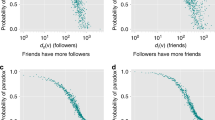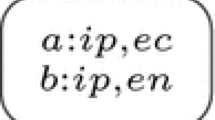Abstract
Diffusion in social networks is a result of agents’ natural desires to conform to the behavioral patterns of their peers. In this article we show that the recently proposed “propositional opinion diffusion model” could be used to model an agent’s conformity to different social groups that the same agent might belong to, rather than conformity to the society as whole. The main technical contribution of this article is a sound and complete logical system describing the properties of the influence relation in this model. The logical system is an extension of Armstrong’s axioms from database theory by one new axiom that captures the topological structure of the network.








Similar content being viewed by others
Notes
Boolean function \(f(x_1,\ldots ,x_n)\) is monotonic if \(f(x_1,\ldots ,x_n)\le f(y_1,\ldots ,y_n)\) for each all Boolean (0 or 1) values \(x_1\le y_1,x_2\le y_2,\ldots ,x_n\le y_n\).
For the sake of completeness we prove this claim in Lemma 20 located in the appendix to this article.
References
Apt, K. R., & Markakis, E. (2011). Diffusion in social networks with competing products. In G. Persiano (Ed.), SAGT 2011, LNCS (Vol. 6982, pp. 212–223). Berlin: Springer.
Armstrong, W. W. (1974). Dependency structures of data base relationships. In Information processing 74 (proc. IFIP congress, Stockholm, 1974) (pp. 580–583). Amsterdam, North-Holland.
Azimipour, S., & Naumov, P. (2016). Lighthouse principle for diffusion in social networks. arXiv preprint arXiv:1601.04098.
Baltag, A., Christoff, Z., Rendsvig, R. K., Smets, S. (2016). Dynamic epistemic logics of diffusion and prediction in social networks. In 12th conference on logic and the foundations of game and decision theory (LOFT), Maastricht, The Netherlands.
Biddle, B. J. (2013). Role theory: Expectations, identities, and behaviors. Cambridge: Academic Press.
Christoff, Z., & Hansen, J. U. (2015). A logic for diffusion in social networks. Journal of Applied Logic, 13(1), 48–77.
Christoff, Z., & Rendsvig, R. K. (2014). Dynamic logics for threshold models and their epistemic extension. In Epistemic logic for individual, social, and interactive epistemology workshop.
Garcia-Molina, H., Ullman, J., & Widom, J. (2009). Database systems: The complete book (2nd ed.). Upper Saddle River: Prentice-Hall.
Goyal, S. (1996). Interaction structure and social change. Journal of Institutional and Theoretical Economics, 152(3), 472–494.
Grandi, U., Lorini, E., & Perrussel, L. (2015). Propositional opinion diffusion. In Proceedings of the 2015 international conference on autonomous agents and multiagent systems, international foundation for autonomous agents and multiagent systems (pp. 989–997).
Granovetter, M. (1978). Threshold models of collective behavior. American Journal of Sociology, 83(6), 1420–1443.
Hyman, H. H. (1942). The psychology of status. In Archives of psychology (Vol. 269). Columbia University.
Kelley, H. H., et al. (1952). Two functions of reference groups. Readings in Social Psychology, 2, 410–414.
Kempe, D., Kleinberg, J., & Tardos, E. (2003). Maximizing the spread of influence through a social network. In KDD 03: Proceedings of the ninth ACM SIGKDD international conference on Knowledge discovery and data mining (pp. 137–146). NY, USA: ACM. http://dl.acm.org/citation.cfm?id=956769
Li, F. H., Li, C. T., & Shan, M. K. (2011). Labeled influence maximization in social networks for target marketing. In 2011 IEEE third international conference on privacy, security, risk and trust and 2011 IEEE third international conference on social computing (pp. 560–563). https://doi.org/10.1109/PASSAT/SocialCom.2011.152. http://ieeexplore.ieee.org/lpdocs/epic03/wrapper.htm?arnumber=6113168.
Liu, F., Seligman, J., & Girard, P. (2014). Logical dynamics of belief change in the community. Synthese, 191(11), 2403–2431.
Morris, S. (2000). Contagion. Review of Economic Studies, 67, 57–78.
Naumov, P., & Tao, J. (2016). Marketing impact on diffusion in social networks. In 12th conference on logic and the foundations of game and decision theory (LOFT), Maastricht, The Netherlands.
Naumov, P., & Tao, J. (2017). Marketing impact on diffusion in social networks. Journal of Applied Logic, 20, 49–74.
Schelling, T. C. (1969). Models of segregation. The American Economic Review, 59(2), 488–493.
Seligman, J., Liu, F., & Girard, P. (2011). Logic in the community. In M. Banerjee & A. Seth (Eds.), Logic and its applications (pp. 178–188). Berlin: Springer.
Seligman, J., Liu, F., & Girard, P. (2013). Facebook and the epistemic logic of friendship. In 14th conference on theoretical aspects of rationality and knowledge (TARK ‘13), January 2013, (pp. 229–238). Chennai, India.
Shibutani, T. (1955). Reference groups as perspectives. American Journal of Sociology, 60(6), 562–569.
Tajfel, H. (1979). Individuals and groups in social psychology. British Journal of Clinical Psychology, 18(2), 183–190.
Turner, R. H. (1956). Role-taking, role standpoint, and reference-group behavior. American Journal of Sociology, 61(4), 316–328.
Xiong, Z., Ågotnes, T., Seligman, J., & Zhu, R. (2017). Towards a logic of tweeting. In A. Baltag, J. Seligman, & T. Yamada (Eds.), Logic, rationality, and interaction (pp. 49–64). Berlin, Heidelberg: Springer.
Author information
Authors and Affiliations
Corresponding author
Additional information
Publisher's Note
Springer Nature remains neutral with regard to jurisdictional claims in published maps and institutional affiliations.
Monotonic Boolean Functions
Monotonic Boolean Functions
In this appendix we prove the property of monotonic Boolean functions that we referred to in the introduction.
Lemma 20
Any monotonic Boolean formula can be written as a disjunction of several disjuncts where each disjunct is a conjunction of several propositional variables.
Proof
Consider any monotonic Boolean formula \(\varphi (x_1,\ldots ,x_n)\). If \(b_1,\ldots ,b_n\) are Boolean values, then by \( \varphi \left( \begin{array}{ccccc} 1 &{} 2 &{} 3 &{} \cdots &{} n \\ b_1 &{} b_2 &{} b_3 &{} \cdots &{} b_n \end{array}\right) \) we denote the Boolean value of formula \(\varphi \) on Boolean arguments \(b_1,\ldots ,b_n\). Consider Boolean expression
Next we show that formulae \(\varphi \) and \(\psi \) are equivalent. Consider any Boolean values \(b_1,\ldots ,b_n\). We will show that \( \varphi \left( \begin{array}{ccccc} 1 &{} 2 &{} 3 &{} \cdots &{} n \\ b_1 &{} b_2 &{} b_3 &{} \cdots &{} b_n \end{array}\right) = 1 \) if and only if \( \psi \left( \begin{array}{ccccc} 1 &{} 2 &{} 3 &{} \cdots &{} n \\ b_1 &{} b_2 &{} b_3 &{} \cdots &{} b_n \end{array}\right) =1 \)
\((\Rightarrow )\) Let \(i_1,\ldots ,i_n\) be all indices i such that \(b_i=1\). Then,
Hence, conjunction \(x_{i_1}\wedge x_{i_2}\wedge \dots \wedge x_{i_k}\) is one of disjuncts in formula \(\psi \). Note that
Therefore,
because conjunction \(x_{i_1}\wedge x_{i_2}\wedge \dots \wedge x_{i_k}\) is one of disjuncts in formula \(\psi \).
\((\Leftarrow )\) In order for a disjunction to have value 1 at least one disjunct must have value 1. Thus, assumption \( \psi \left( \begin{array}{ccccc} 1 &{} 2 &{} 3 &{} \cdots &{} n \\ b_1 &{} b_2 &{} b_3 &{} \cdots &{} b_n \end{array}\right) =1 \) and Eq. (2) imply that there are indices \(i_1,\ldots ,i_k\) such that
and
Note that \( (x_{i_1}\wedge x_{i_2}\wedge \dots \wedge x_{i_k})\left( \begin{array}{ccccc} 1 &{} 2 &{} 3 &{} \cdots &{} n \\ b_1 &{} b_2 &{} b_3 &{} \cdots &{} b_n \end{array}\right) = b_{i_1}\wedge \dots \wedge b_{i_k} \). Thus, equality (3) implies that \(b_{i_1}=\dots =b_{i_k}=1\). Hence, it follows from Eq. (4) that
Therefore,
due to the assumption that formula \(\varphi \) is monotonic. \(\square \)
Rights and permissions
About this article
Cite this article
Morrison, C., Naumov, P. Group Conformity in Social Networks. J of Log Lang and Inf 29, 3–19 (2020). https://doi.org/10.1007/s10849-019-09303-5
Published:
Issue Date:
DOI: https://doi.org/10.1007/s10849-019-09303-5




